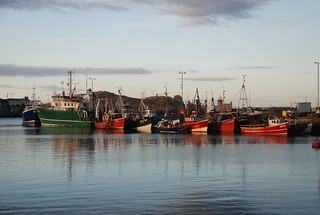
I wrote here a couple of posts ago that I would try to share some of our boat search process on the blog. I'm guessing a lot of our readers are really in the RV community and won't care one whit, but I've received messages from a number of others that they may be following the same path some day, and would like to know more. Also, we get suggestions from time to time to consider some boat or other, many of which are really orthogonal to what we are looking for. Perhaps sharing a little more of our process will clarify things a bit.
Let me start by saying that I've always had the travel bug, and I had two great ambitions rattling around in the back of my head for "some day," presumably in retirement. One was to convert a tour bus and see the U.S. and perhaps beyond. And the other was to buy a sailboat and cruise the world. Even the most recent of our readers will know that I have more or less achieved the first ambition: in the eight years we have lived full-time aboard Odyssey, we've been to all of the lower 48 continental states, and six states in Mexico. We've racked up nearly 150,000 miles on the bus, and another 10,000 apiece on our motorcycles or scooters in that time.
For sure there are places we have not yet been and to which we would still like to go. Alaska, for example. And early on in our bus adventure I had harbored thoughts of going down the east coast of Mexico and perhaps into some of Central America. None of that is really "off the table," and in our "take life as it comes" philosophy, we might very well yet explore one or more places on our grand list while still in the bus and before we have a boat. In other words, we are not "done" by any means, and absent other forces at work we could easily continue the bus adventure another decade -- and we still will not have seen or done everything we'd like.

Old school GPS. You can't get to Alaska from here.
All of that said, we have, though, reached a point where we can honestly say to ourselves that we've had a good run at it, and we can be happy with what we've achieved without feeling the need to press on regardless, whether that's one more year or ten. And we are aware that boating is a much more physically demanding environment than RVing -- we want to turn our attention to the water now, while we are still young and fit enough to enjoy it to the fullest. In fact, we've been told on a number of occasions that we've done things out of sequence: the conventional progression for an adventurous couple, so we're told, is Sail Boat, Motor Boat, Motor Home, Nursing Home. We, apparently, put the Motor Home well out of sequence by starting with that first.
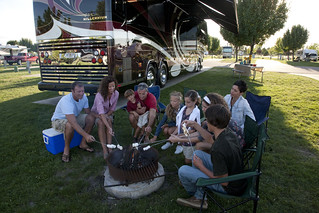
These people may also be too young for their bus.
As it turns out, we will also be skipping the Sail Boat portion of the program. As I said earlier, one of my ambitions had been to get a sailboat and cruise the world. That's because I started sailing long before I ever drove a motor boat, and also conventional wisdom has been that the only small recreational vessels which can cruise anywhere in the world operate by wind power.
Louise, by contrast, will not sail. I had more or less written off the possibility of cruising the world, until one eventful day at the Seattle boat show while finishing up construction on Odyssey. Rather than repeat that whole story here, I will refer you instead to the latter half of this post, wherein I described what brought us to the boat show and the epiphany that we had there.
You might discern from that post, six full years ago, that we still had much to learn about long distance power boats, and were even on the fence as to whether or not we wanted ocean-crossing capability. In the ensuing six years, we've done a great deal more research, to include taking in eight or so Trawler Fest shows, going on two separate week-long training cruises, reading hundreds of articles, books, and blogs, and generally immersing ourselves in "trawler" culture as much as possible. All of this culminated in our retaining a broker back in October to help us find a boat, an individual whom we had met at a number of shows and with whom we had a good rapport and friendship.
After going aboard hundreds of vessels (each Trawler Fest hosts anywhere from 50-100 boats), and reading voraciously for six years, we've managed to somewhat prioritize our wants and needs when it comes to the boat. The reality of boating is that every boat represents one or more compromises, and the point we have come to has more to do with knowing what compromises we are willing to make, rather than having a bullet-point list of must-haves and must-nots. And, of course, there is the small matter of budget -- the "ideal" boat does not exist, but you can get a lot closer to it with an infinite supply of cash, something we do not have.

His face is his fortune. Probably not enough to buy a boat.
That's a really long lead-up to where we are at today in the search process, and why we have mostly crossed quite a number of boats off the list, including most recently the Hatteras 58 LRC. Let me start off by saying we are looking for a "trawler," which pains me to say, because that word is poorly defined even in the industry, has been co-opted for marketing purposes by many boats that don't really belong in the class. It is even more confusing to our friends, family, and non-boating readers, for whom it likely conjures up images of shrimpers on the bayou, or worse, those crab boats on "The Deadliest Catch." Or possibly the Andrea Gail.
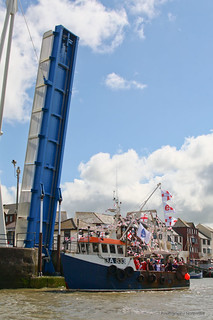
Frugal boaters agree that old tires make the best fenders.
In recreational boating, a trawler is generally a roomy power boat that moves at displacement speeds, with relatively small engines, relatively good fuel economy, and usually all the comforts of home. They are a marked contrast from, for example, speedboats, which plane over the water, and are usually distinguished from motor yachts which, while similarly outfitted in the living spaces, are also designed to plane over the water and have enormous engines to allow them to do so.
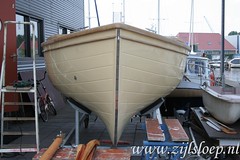
Hull shape is the key.
Since no one can really agree on the definition, there are now all manner of boats with semi-planing hulls and larger engines which are also marketed as trawlers, and there are likely boats that more closely align with the definition above which, for whatever reason, are marketed as something else. We're immune to marketing hype, however, and we are only looking at boats which move at hull speed, and prefer boats with engines to match that goal, and fuel tanks to provide great range.
Having settled that, next up on the list is size. There is a joke in the recreational boating community that if you have a "Whatchamacallit 50," then your boat is 60' long when bragging about it at the yacht club, and 40' long when paying the dock master for a slip. At some level, this joke is a fitting metaphor for the size we are looking for.
There is a mantra in the cruising community that one should buy the smallest possible boat that fits everything needed. There are good reasons for this: the smaller the boat, the more anchorages into which it will fit, the easier it is to handle in close quarters, and the less expensive it will be to dock (marinas usually charge by the foot of overall length for dockage), operate, and maintain.
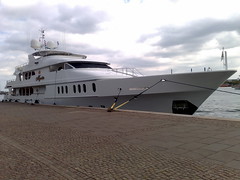
Too big.
That said, there are downsides to smaller boats as well. For one thing, the longer the boat, the safer it will be in heavy seas, all else being equal. For another, there is the matter of hull speed: displacement boats are limited in speed by a formula related to waterline length. While counter-intuitive for many people, what this means is the longer the boat, the faster it goes. It is simple physics, and is immutable; the only way to make a boat go faster than hull speed is to make the bottom hydrodynamic, and push it so hard that the hull comes up out of the water and skips along on top -- planing.
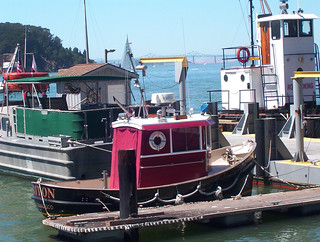
Too small.
What this means for us is that we have decided our boat should be at least 40' at the waterline, which usually translates to 43'-47' overall. That's good for a top speed of close to nine knots, and should handle fairly rough seas reasonably well. And, until recently, we had also decided our boat should be at most 52' overall. That's to keep dockage costs down, reduce insurance premiums, make for fairly easy handling with just two of us aboard, and, not least of all, keep us from rattling around a ton of extra space that we don't really need.
Trawlers in this size range generally have two staterooms (bedrooms) and one or two heads (bathrooms). Below that and they start to get cramped, and above this length they often will have three or more staterooms and heads -- more spaces and equipment than we want to clean and maintain. For the last six months, we have therefore concentrated our search on trawlers from 43' to 52' overall.
As I have discussed here over the last few posts, we talked ourselves into a particular 60' boat in Washington, which is clearly well past our self-imposed limit. The boat had three staterooms and three heads, fully one more of each than we need, and that extra ten feet or so of boat to maneuver and pay for at the dock. But all boats are compromises, and this one seemed to meet every other criterion, in a way that no other boat we'd seen to date had. In the end, it fell through because of some technical issues with the boat that lurked beneath the surface. (As a side note, we'd still buy this boat if the seller would drop the price by the amount we'd need to spend at a boat yard fixing those issues.)
Having broken the magic 52' barrier with this boat, we decided to expand our search to include boats up to 60' in overall length. That's what led us, for instance, to look at the Hatteras 58 LRC last week. But, and this is a key concept, the size of a boat is not only measured by overall length, and, in fact, this number can be very deceiving.
The 60' boat we liked, a Dutch-built aluminum model, had a very low "house" (the part of the boat that is built above the main deck and protrudes above the hull). Wide walk-around decks, a very long foredeck, and generous afterdeck (the areas in front of and behind the house, between the house and the bow and stern of the boat) combined with the low house to make for a very sleek vessel with interior space, above deck, commensurate with many boats more in the 50' range. Even below decks, the space was constrained by a very fine and highly raked bow, and sleek sides.
In marked contrast, the Hatteras 58 was a much larger boat, even though it had two feet less overall length. The waterline length of the Hatteras was actually greater, and the boat was both wider and taller, both below decks as well as above. This boat, for example, had four staterooms and four heads, one more of each than the 60' boat. In short, it was really too much boat for us on almost all counts. To top it off, it was already at the top of our budget, leaving little for any changes, and lacked a bow thruster, an essential feature (for us) that we would have to add before we could even leave the dock.
Along with type and size, among our top search criteria is seaworthiness. We are not looking at any boats that can not handle "green water" across the deck -- meaning ocean waves breaking across the decks of the boat. This rules out boats with poorly sealed doors and windows, low freeboard (the distance from the waterline to the lowest opening through the hull), insufficient ballast (heavy material at the bottom of the hull to right the boat when it tries to roll over, like those old punching bags or Weebles toys), or attachments to the decks that can't handle rough weather.
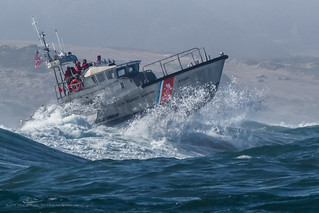
Not a displacement-hull trawler. Also not very big waves. But plenty of testosterone.
While seaworthiness may seem like a no-brainer, there are plenty of so-called trawlers that are not meant to be taken to sea in heavy weather. Even many salt-water boats spend their whole lives in protected waters such as estuaries like San Francisco Bay, or the Intracoastal Waterways. Many of these boats are fine choices even for the Bahamas, just a day's passage from protected waters in Florida which can be made in favorable weather, but can not weather an open ocean crossing.
Whether or not we ever take our boat across the Atlantic, for example, to cruise the Mediterranean, or across the Pacific to Hawaii and the South Pacific, it is a sure bet that we'll at least be out in the ocean a fair bit. Even getting from San Francisco to LA requires a stint in open ocean, and we won't buy a boat that is not capable of making such a passage in relative safety.
From here, the list starts to get more fuzzy, and we enter the territory of compromises. Probably next on our wish list is range. Even the most seaworthy boat can't cross the Atlantic without a range of at least 2,000 nautical miles, so if we ended up with a boat with less range than that, we'd be limited to
"coastal cruising." Range is a function of the fuel mileage of the boat and size of the tankage, and the fuel mileage is somewhat controllable by speed. Most of the boats we are looking at would have to slow down to about six knots to make a crossing on the available tankage.
After range would come stabilization. Stabilization counteracts the tendency of the boat to roll from side to side, and is a matter of comfort and safety in heavy seas. Some hull shapes are inherently more stable than others, but many boats can benefit from the addition of a stabilization system. There are lots of ways to do it, including passive fins protruding from the hull known as "bilge keels," active fins which are electronically controlled by a gyroscope and are steered, much like airplane ailerons, to counteract the roll, towed "paravane" stabilizers suspended from poles on either side of the boat (and imparting more of a fishing-trawler appearance to it), massive gyroscopes, and anti-roll tanks full of liquid ballast, to name a few. Adding stabilizers to a boat that does not already have them can be an expensive proposition, so we are trying to look only at boats that have them, or have plenty of headroom in the price to add them.

Boat with paravane stabilizers out.
While it would seem at this point that next on the list should be lots of technical items like engine systems, generators, water makers, and the like, or maybe bridge electronics like radar sets and chart plotters (what a GPS navigation system is called on a boat), or even safety equipment like life rafts and radio beacons, I am not really concerned about those. The more we pay for the boat, the more of these things need to be good-to-go, but I am confident in our own abilities to update, upgrade, repair, or replace these kinds of things as needed to make the boat safe, comfortable, and efficient. Instead, our next category is accommodations.
At some level, this can really be moved to the top of the list, because, in reality, if the layout and accommodations don't feel right to us the moment we step aboard, we seldom get as far as looking at the engines, fuel tanks, stabilizers, and the like. We've stepped aboard more than one salty and seaworthy boat that could easily go around the world without even breathing hard, only to make an about-face after sitting down in the salon (living room) or stepping into the head.
Some of our non-negotiables here include a panoramic view from the main living area, which is where we would expect to spend most of our waking hours aboard. A master stateroom with at least a "queen" berth (bed), which I put in quotes because many berths are not rectangular and the mattress might only measure up to queen standards in a specific spot. A master head with enough counter space to put in and take out contact lenses, and a shower large enough to stand in and wash comfortably. Room somewhere for a washer and dryer. And a guest stateroom with comfortable berths for two adults.

You can really get the feel of a boat from a good model.
I have to confess that it is really this accommodation category that makes me appreciate Odyssey -- so many of the boats we have visited represent a step down in overall comfort and convenience from what we have today. And while I am willing to do (or invest in) some minor remodeling to make some of the spaces more closely align with our needs, we don't want to repeat the Odyssey experience, wherein we ended up gutting the bus and starting from scratch, a costly lesson.
So there you have it, a run-down of the top considerations for our boat search. To summarize, we are looking for a robust, open-ocean boat in the 43'-60' range that moves efficiently at hull speed, has 2,000-mile range, stabilizers, and a comfortable layout. Ideally we'd like walk-around side decks, a "fly bridge" (outside controls) in addition to the pilot house, draft less than 6', air draft (height with all masts lowered) less than 19', a double or queen berth in the guest stateroom, and good access for scuba diving. There must be a way to get the boat to port even if an engine fails, which can be a second engine or a "get-home" system such as hydraulic drive from the generator. We'd like to stick to two staterooms, but will settle for three if the price is right and all else meets our needs. The rest, as they say, is negotiable.
Finally, a number of people have written to express their concerns about the future of this blog. Rest assured that I will continue blogging even after we have moved to a boat. Most likely that will be right here at OurOdyssey.BlogSpot.com, because our life will still be an odyssey even if that is not the name of the boat. And the 1,700 or so posts already here thus far will remain as an archive of our time on the road. I hope you will continue to follow us, but we do understand that quite a few of our readers are here specifically for the RV or bus content. I am sure we will also pick up some new readers who are more interested in cruising than RVing.
All photos used under a Creative Commons license. To see title and creator, hover over or click on each picture.
I have been reading your blog for a few years and can say that I am really looking forward to your new adventures. Also thank you for continuing the blog. You always amaze me with your ability to fix just about anything (a skill that I suspect will come n very handy going forward).
ReplyDeleteJim
Very nice article. It really does a good job illuminating what you're looking for in a boat. This is something that may be in my future someday (though probably a long way off). I look forward to your reading about your maritime Odyssey.
ReplyDeleteOne thing I'm curious about is your mention that a bow thruster is an absolute must have. From what I've read, as long as you've got twin screws, you can use throttle manipulation to do just about everything you could do with a bow thruster. Are you intent in getting a bow thruster even on a twin screw boat?
That's a great question. The answer is that, yes, as total newbies, we'd like a bow thruster on any boat longer than 45' at the waterline. Below that I can be content with twin screws alone, and I'm sure that after a year or so on the water, I would be able to dock even the Hatteras, a 58' twin, without making use of a thruster. Even the professional captain who skippered us back to Lake Union aboard the 60-footer, also a twin, made use of the bow thruster on that boat several times, including in the Ballard Locks, where it was more precise and effective than using the mains would have been.
DeleteAdd also add that while you can move the bow about using twin engines, how effective it is can be very variable. Depending upon propeller size and location and engine RPM at idle the bow may not respond well. In my current boat - a 43' express cruiser - the props are small and close to the center line. This means that at idle speed, the boat doesn't respond well and I need to use the bow thruster. Sure, I could increase the RPMs to get more movement, but moving beyond the idle detente when trying to move the bow sideways really isn't a good idea. This is an "ask me how I know" kinda thing :-)
DeleteI'd also add that having MORE maneuverability rather than LESS is always a good thing when you're CQMing around a marina full of multi-million dollar toys.
Rest assured we will continue to follow along on your odyssey no matter where it leads you.
ReplyDeleteOn the other hand if you are yet to be awhile on your land based journey remember that in between Alaska and the 49th parallel lays a land of uncompromising beauty and quite friendly folks. C'mon up for a visit sometime although I have to confess we don't usually have a lot of Red Cross volunteer assignments happening here during our summers.
As a previous blue water sailor and current part time RV'er, I can appreciate your desire to cruise. My strong opinion is that a motor sailor is a much better choice than a trawler. We carried 125 gallons of fuel which gave us a 1200 mile range under power, but typically crossed oceans with 90% of our fuel (which is often 50% more expensive at marinas in other parts of the world than U.S. truck stops) still aboard. If you really plan on powering across oceans, you must have really deep pockets! And, sails provide stabilization.
ReplyDeletePlease go back and read the post I linked at the very beginning. Anything with sails on it is simply out of the question; even the 248' Windjammer Polynesia sparked a panic attack when she put all her sails up. This is not a rational thing, it's a phobia. I'm sure it could be fixed with years of therapy. I am equally certain that diesel fuel is cheaper.
DeleteSpeaking of Red Cross volunteering, what are your plans with this when you are on a boat?
ReplyDeleteHow we can continue to help the Red Cross once we move aboard has yet to be determined. While we are still in the US and mostly within reach of a marina someplace, we might be able to continue to respond to disasters, but until we move aboard and get some experience with the process it is too early to tell. Some of the other work we do, including teaching, curriculum development, procedural documentation, and equipment evaluation, are probably less of an issue. And, of course, we will continue to be donors.
DeleteAwesome and exciting stuff - I love the thinking you have around this.
ReplyDeletePersonally - I think bus to boat is an ideal natural progression, and I hope to eventually end up rafted up with you guys somewhere exotic passing the box of wine around the Yachtub... *grin*
Ooh, what will the neighbors think -- a raghanger rafted to a stinkpot!
DeleteWe are readers forever, land or sea, so you're stuck with us. Nice "heads up" on the boat saga! We brought an 82' houseboat from Paducah, Ky to Kerr lake in Oklahoma a few years ago, 10 days and 19 locks, so we know what "too big" means. Thanks for sharing. Steve & Carol
ReplyDeleteWow, 82' -- I can hardly imagine. We could lose one of the cats and not find her for weeks!
DeleteThank you for this post. As someone who knows almost nothing about boats but is fascinated by life aboard them, I am definitely going to keep following your travels.
ReplyDeleteSomething we have discovered since purhcasing Gray Hawk is that the usefulness of a flybridge is directly related to where you do your boating. That may be obvious to you but it wasn't to me. If/when we get footitis I will hold out for a pilothouse with 360 degree visibility. On anything under 50' a pilothouse seriously cuts up your useful space but since you have already succombed to footitis you may want to consider making that a requirement. A good pilothouse becomes the cruising social point. The flybridge on the other hand is entirely weather dependant. I don't have direct experience but I suspect too much heat would be just as unpleasant on the flybridge as too little. And in the Pacific Northwet its just too wet up there most of the time.
ReplyDeleteOn the subject of bowthrusters - they are wonderful and you need a good one - high HP, high voltage or better yet hydraulic. I can sidepass Gray Hawk directly into a 20+ knot wind - docking is absolutely never an adventure and I never have to move the throttles ahead of idle. Its also really handy for lining up to retrieve prawn traps off that high Defever prow.
Its probably too small for you now & I'm sure Curtis knows about it but Ron & Charma Owen's 44 is back on the market.
Thanks for chiming in, Bob. We did know about the flybridge issue, one consequence of intentionally going to shows in all four corners of the country. When a boat model has a flybridge as an option (e.g. tugs from American or Nordic), PNW boats are seldom seen with them, and FL boats are seldom seen without. On that same theme, it's probably easier to sell a flybridge boat in the PNW than a non-flybridge model in FL. We've also found that many PNW boats are equipped with diesel heat of some sort, whereas boats in the southeast almost never have heat, other than perhaps reverse cycle on the AC. When all is said and done, I think we'd rather have a boat that was equipped for the PNW, and then retrofit it for the southeast, rather than the other way 'round.
DeleteAs regards thrusters, our preference is for hydraulic, but we'll take whatever comes on the boat. If we had decided to move forward with the Hatt 58, that would not have been an option and I think we'd have installed a 24v unit with dedicated batteries. Hatts, BTW, are 32-volt boats, necessitating an entire extra bank almost no matter what you do -- you can't make 32v from 12v batteries, so 8v golf-carts are used.
The 44 was never on our list, for several reasons. We generally don't like sundeck models with the helm in the salon (and it sounds like you are arriving at the same conclusion), and while offshore performance is likely good, it's definitely not a transoceanic boat. The smallest DeFever we've considered is the later model 46 RPH, but examples of that are really above our budget.
Ironically, my favorite DeFever design is the 53 POC, and I'd buy that in a heartbeat if it didn't have those enormous engines -- I could even live with the semi-planing hull shape so long as she also had stabilizers. Given that this boat can be found in our price range, I sometimes think about what it would take to make it more fuel efficient at lower throttle, perhaps re-propping and downsizing the injectors.
Any time you want to invite us aboard to help consume some of those prawns, BTW, give me a shout :)
I love having the helm in the salon in a boat our length. Cutting it up to make a pilothouse on anything less than 50 feet would be silly IMHO. The important thing is to have an area where everybody can easily congregate in comfort while you're underway.
DeleteAnd you're welcome aboard anytime we're there but we never seem to meet up at the same place at the same time. I will however have the Malibu in the water within the next couple of weeks - maybe you can pop over the border and rip a few sessions on a prairie lake as you make your way east. We're only a few hours north of Fargo.
Sean, Thanks for the informative over-view.
ReplyDeleteAs a "land lubber" (and it appears that I will remain as one) I have always been intrigued by the option of a "live aboard" coastal style vessel. After a little research we decided that the initial / maintenance / slip costs would be too high for us and never have investigated the option further.
We started a "full timer" RV situation 18 years ago with the thought that we'd go for a couple years. All these years later we still have not tired of the life style. I'll thoroughly look forward to your "water transition" if it ever occurs.
Doug Smith
Montana
No matter the mode of transportation, I will remain a close blog reader. I have drove buses for (singing) groups but I have never stepped foot on a boat that doesn't have the word "bass" along with. I look forward to learning as your Odyssey continues.
ReplyDelete